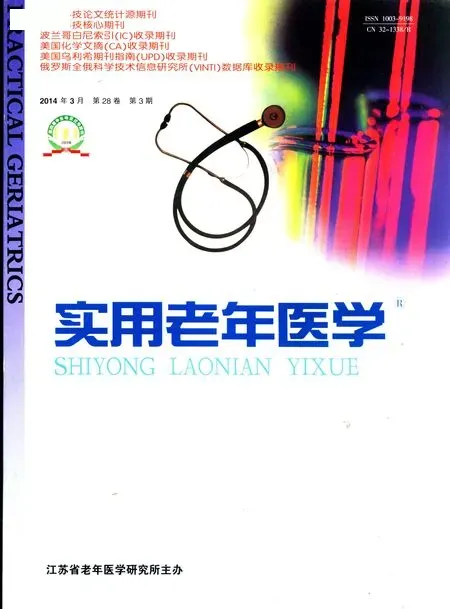区域性振动刺激改善老年脑卒中步行功能的临床研究
李林 许光旭 孟殿怀 龚晨
区域性振动刺激改善老年脑卒中步行功能的临床研究
李林 许光旭 孟殿怀 龚晨
目的探讨下肢区域性振动刺激对脑卒中偏瘫患者步行速度与稳定性的作用。方法脑卒中偏瘫患者26例,坐位下接受频率16 Hz、振幅4 mm的下肢区域性振动刺激10 min,评定振动前后小腿三头肌张力(改良Ashworth分级,MAS)、3 m计时起立行走时间(TUGT)和10m最大步行速度(MWST),分析干预前后MAS、TUGT、10m MWST差异性。结果振动后与振动前评定数值比较发现振动后小腿三头肌张力MAS评分没有显著性变化(P>0.05),TUGT及10 m MWST均增加,差异有统计学意义(P<0.05)。结论下肢区域性振动刺激能够提高脑卒中患者即刻的步行速度及稳定性,改善步行功能,而对缓解小腿三头肌痉挛没有显著作用。
振动刺激;脑卒中;步行能力;平衡;肌张力
老年脑卒中已经成为我国致死和致残首要因素,Jorgensen等[1]认为约63%的脑卒中患者在发病早期失去独立步行能力,影响其独立性和生活质量[2]。康复过程中下肢功能障碍及异常的步行模式也常持续存在,增加患者尤其是老年卒中者的跌倒风险[3]。
外源性机械振动能使肌肉肌腱复合体长度产生变化,刺激本体感受器引发反射性的神经肌肉兴奋性改变(也即是肌梭兴奋激活α运动神经元,梭外肌产生收缩的牵张反射途径)来调节肌肉的兴奋性[4⁃5],增强下肢肌力和平衡能力[6⁃8]。Chan等[9]研究发现通过全身振动训练能降低慢性卒中患者踝跖肌痉挛而提高其步行能力。然而,部分研究认为全身振动训练没有明确地改善脑卒中患者平衡及步行稳定性的作用[10⁃11],对于振动是否有利于步行功能改善存在争议。本研究目的在于通过临床振动前后对比研究,确定区域性振动刺激是否有助于改善脑卒中步行功能。
1 对象与方法
1.1 研究对象 符合入组条件的26例脑卒中患者均来自南京医科大学第一附属医院康复医学中心。受试者理解整个试验流程,并充分配合。
1.1.1 入组标准:年龄50~80岁,脑卒中偏瘫患者,首次发病,病程≥1月,足下垂(摆动相踝关节不能达中立位),核磁共振证实为缺血性或出血性病变,独立或监护下无辅助工具步行距离≥10 m。
1.1.2 排除标准:双侧大脑病变;踝关节高肌张力状态(改良Ashworth分级,MAS:3级或4级);精神疾病;认知损伤(MMSE<23分);曾患过导致运动功能下降的疾病(神经疾病、糖尿病、风湿病或关节畸形);患侧下肢肌群曾接受溶神经技术或化学神经阻断术治疗;入组前1月内曾接受或正在接受抗痉挛药物治疗;参与其他临床试验。
1.2 方法
1.2.1 试验流程:受试者保持安静坐位休息5 min后开始试验,振动刺激前受试者接受小腿三头肌痉挛程度(MAS方法测定),3 m计时起立行走时间(TUGT)测试及10 m最大步行速度评定(10 m MWST),随后进行10 min振动刺激(方式如下),振动后即刻再次评定。
1.2.2 刺激方式:(1)体位:上身放松,屈髋屈膝90°,双足尽可能平均负重置于振动板上;(2)振动参数:频率16 Hz、振幅4 mm的低频足底振动刺激(德国Wellengang公司的Wellengang site,可调节频率1~16 Hz,振幅4 mm);(3)注意事项:刺激过程中可适时调整患者姿势以保证体位的一致性。
1.2.3 康复功能评定:(1)TUGT测试:测试开始时受测试者坐在椅子上(有扶手和靠背,椅面距地面约46 cm),听到测试者的开始指令后,由坐位站起向前走至3 m标志线处,再转身向回走至椅子前坐下。测试者记录受测者背部离开椅背至臀部再次接触椅面的时间。测试2次平均值作为测试结果,单位为s[12]。(2)10 m MWST测试:将测试用的16 m走道从起点到终点依次标记分割为3 m、10 m、3 m。测试开始,受测试者从起点以尽可能最快的速度行走至终点。测试者记录受试者走完中间10 m所需要的时间,测试2次平均值作为测试结果,单位为s。通过时间计算最大步行速度,单位为m/s[13]。(3)MAS评估:为便于数据统计,将MAS的分级(0、1、1+、2、3、4)用对应数值(0、1、2、3、4、5)表示[14⁃15]。
1.3 统计学分析 所有统计分析采用SPSS 19.0软件完成,计量资料均以均数±标准差形式表示,振动前后的比较采用配对资料t检验,P<0.05为差异有统计学意义。
2 结果
2.1 一般资料 26例脑卒中受试者中男17例,女9例,年龄51~77岁,平均(66.54±6.54)岁,其中缺血性脑卒中18例,出血性8例,左侧偏瘫9例,右侧偏瘫17例,全部受试者下肢Fulg⁃Meyer评分为(25.07± 2.04)分。
2.2 试验前后下肢功能比较 与振动刺激前比较,振动刺激后TUGT显著降低(P<0.05)、10 m MWST显著升高(P<0.01),而MAS无显著变化(P>0.05)。见表1。
表1 振动前后下肢功能比较(s)

表1 振动前后下肢功能比较(s)
注:与振动前比较,∗P<0.05,∗∗P<0.01
指标振动前振动后TUGT(s)17.6±7.33 16.15±6.70∗10 m MWST(m/s)1.51±0.49 1.62±0.53∗∗MAS(级)2.46±0.51 2.27±0.45
3 讨论
振动是一种作用力、加速度及位移持续发生周期性变化的机械震荡。常见的全身振动训练就是训练者站于振动平台上,静止或完成相应动作同时接受由振动平台产生的正弦波形式的振动刺激,由于人体的解剖结构特点,振动刺激在人体的传导是从一区域到下一区域,比如从足到小腿,再从小腿到大腿,而单独身体某一区域(如下肢等)接受振动平台刺激的振动形式即为区域性振动[16],相比全身振动而言,振动强度较小,对老年人及有功能障碍者的适应性更佳。
肌肉组织被拉伸,肌梭尤其是初级肌梭末梢被激活,产生牵张反射,通过单突触及多突触传导通路的反馈调节使肌肉兴奋性及其与协同肌肉间同步性增加。Ritzmann等[17]研究认为全身振动引起肌肉牵张反射同时检测到其表面肌电信号相对应增加,认为可以在重复地牵伸肌肉及肌腱系统过程中通过诱发出牵张反射来影响肌肉的兴奋性。
另外,振动刺激可通过外周感受器传递信息对中枢神经系统产生调节作用。肌肉振动作为一种强的本体觉刺激,能优先产生Ia传入冲动到达躯体感觉和运动皮层[18]。Christova等[19]通过功能性磁共振检测表明30 Hz的手部振动刺激可以引起感觉运动皮层神经持续性的调节效应。Marconi等[20]使用经颅磁刺激表现重复局部肌肉振动治疗联合物理治疗能帮助减低卒中后患者受损半球皮质脊髓束兴奋性及皮质内抑制系统的异常。以上研究提示:可能存在外源性振动刺激与人体运动器官产生生物谐振[21⁃22],并在中枢存在一定的谐振机制。
研究表明在促进卒中后下肢力量和躯体控制方面,全身振动训练是一种相对安全和可行的方法。短时间的全身振动训练(30 Hz,3 mm)能对脑卒中患者的本体感觉相关的姿势控制产生促进作用[23]。Chan等[24]发现全身振动训练(12 Hz,4 mm)能降低脑卒中患者偏瘫侧痉挛肌肉的张力,改善起立行走测试和10 m步行速度测试表现,提高步行功能。
全身振动膝关节屈曲角度较小时,机械能量传导到上肢、躯干及头部产生不良作用,需要保持26°~30°的屈膝半蹲位来避免,但这种体位对训练者下肢肌力和姿势控制能力要求较高[25]。部分脑卒中患者不能耐受无支撑的站立位全身振动刺激,Miyara等[26]采用直膝,屈髋90°的体位在振动平台上对受试者整个下肢进行30 Hz,4~8 mm的振动刺激,并证实该种刺激方式可改善卒中患者步行功能。由于足底及踝关节周围的肌梭和高尔基腱器官等本体感受器在控制身体平衡及维持姿势有重要作用[27],本试验中老年卒中患者屈膝90°坐位下接受接触足底、仅对小腿和足起主要振动作用的下肢区域性振动刺激,结果显示该种振动刺激对其步行功能有促进作用。
振动刺激缓解肌肉痉挛的机制尚未明确。本试验中小腿三头肌振动前后的痉挛程度评估结果提示下肢区域性振动刺激没有明显的抗痉挛作用,还有待进一步的研究。
试验不足之处是没有对照组,并且振动刺激作用时间仅10min,虽然完成了可行性的研究目的,但评定的即刻效果并不能对长期的作用效果做出推断,需要进一步的研究补充和证实。
[1] Jorgensen HS,Nakayama H,Raaschou HO,et al.Stroke. Neurologic and functional recovery the Copenhagen Stroke Study[J].Phys Med Rehabil Clin N Am,1999,10(4):887⁃906.
[2] Lord SE,Mcpherson K,Mcnaughton HK,et al.Community ambulation after stroke:how important and obtainable is it and whatmeasures appear predictive?[J].Arch Phys Med Rehabil,2004,85(2):234⁃239.
[3] 杜梅,许光旭.老年人跌倒的危险控制与康复预防[J].实用老年医学,2013,27(4):334⁃337.
[4] Cardinale M,Bosco C.The use of vibration as an exercise intervention[J].Exerc Sport Sci Rev,2003,31(1):3⁃7.
[5] Cochrane DJ,Loram ID,Stannard SR,et al.Changes in joint angle,muscle⁃tendon complex length,muscle contractile tissue displacement,and modulation of EMG ac⁃tivity during acute whole⁃body vibration[J].Muscle Nerve,2009,40(3):420⁃429.
[6] Fort A,Romero D,Bagur C,etal.Effects ofwhole⁃body vi⁃bration training on explosive strength and postural control in young female athletes[J].J Strength Cond Res,2012,26(4):926⁃936.
[7]Pollock RD,Martin FC,Newham DJ.Whole⁃body vibration in addition to strength and balance exercise for falls⁃related functionalmobility of frail older adults:a single⁃blind ran⁃domized controlled trial[J].Clin Rehabil,2012,26(10):915⁃923.
[8] Liao LR,Ng GYF,Jones AYM,etal.Acute effects ofwhole body vibration on leg muscle activity,oxygen consumption and heart rate in individuals with chronic stroke[J].Hong Kong Physiotherapy Journal,2013,31(1):49⁃50.
[9] Chan KS,Liu CW,Chen TW,etal.Effects of a single ses⁃sion ofwhole body vibration on ankle plantarflexion spasticity and gait performance in patients with chronic stroke:a ran⁃domized controlled trial[J].Clin Rehabil,2012,26(12):1087⁃1095.
[10]Brogardh C,Flansbjer UB,Lexell J.No specific effect of whole⁃body vibration training in chronic stroke:a double⁃blind randomized controlled study[J].Arch PhysMed Reha⁃bil,2012,93(2):253⁃258.
[11]Lau RW,Yip SP,Pang MY.Whole⁃body vibration has no effect on neuromotor function and falls in chronic stroke[J]. Med Sci Sports Exerc,2012,44(8):1409⁃1418.
[12]Podsiadlo D,Richardson S.The timed“Up&Go”:a testof basic functionalmobility for frail elderly persons[J].JAm Geriatr Soc,1991,39(2):142⁃148.
[13]Nascimento LR,Caetano LC,Freitas DC,et al.Different instructions during the ten⁃meterwalking test determined sig⁃nificant increases inmaximum gait speed in individuals with chronic hemiparesis[J].Rev Bras Fisioter,2012,16(2):122⁃127.
[14]Mutlu A,Livanelioglu A,GunelMK.Reliability of Ashworth and Modified Ashworth scales in children with spastic cerebral palsy[J].BMCMusculoskelet Disord,2008,9:44.
[15]Chua KS,Kong KH,Lui YC.Botulinum toxin A in the treatment of hemiplegic spastic foot drop⁃clinical and func⁃tional outcomes[J].Singapore Med J,2000,41(5):209⁃213.
[16]Rittweger J.Vibration as an exercise modality:how it may work,and what its potentialmight be[J].Eur JAppl Phy⁃siol,2010,108(5):877⁃904.
[17]Ritzmann R,Kramer A,Gruber M,etal.EMG activity dur⁃ingwhole body vibration:motion artifacts or stretch reflexes?[J].Eur JAppl Physiol,2010,110(1):143⁃151.
[18]Marconi B,FilippiGM,Koch G,etal.Long⁃term effects on cortical excitability and motor recovery induced by repeated muscle vibration in chronic stroke patients[J].Neurorehabil Neural Repair,2011,25(1):48⁃60.
[19]Christova M,Golaszewski S,Ischebeck A,et al. Mechanical flutter stimulation induces a lasting response in the sensorimotor cortex as revealed with BOLD fMRI[J]. Hum Brain Mapp,2013,34(11):2767⁃2774.
[20]Marconi B,FilippiGM,Koch G,etal.Long⁃term effects on cortical excitability and motor recovery induced by repeated muscle vibration in chronic stroke patients[J].Neurorehabil Neural Repair,2011,25(1):48⁃60.
[21]张园园,许光旭,张文通,等.人体肌肉振动激活频率的初步研究[J].中华物理医学与康复杂志,2012,34(4):241⁃244.
[22]张文通,许光旭,王红星,等.脊髓运动神经元谐振频率的电生理分析[J].中华物理医学与康复杂志,2013,35(5):348⁃350.
[23]van Nes IJ,Geurts AC,Hendricks HT,et al.Short⁃term effects of whole⁃body vibration on postural control in unilateral chronic stroke patients:preliminary evidence[J].Am JPhys Med Rehabil,2004,83(11):867⁃873.
[24]Chan KS,Liu CW,Chen TW,et al.Effects of a single ses⁃sion ofwhole body vibration on ankle plantarflexion spasticity and gait performance in patients with chronic stroke:a ran⁃domized controlled trial[J].Clin Rehabil,2012,26(12):1087⁃1095.
[25]Cochrane DJ.Vibration exercise:the potential benefits[J]. Int JSports Med,2011,32(2):75⁃99.
[26]Miyara K,Matsumoto S,Uema T,et al.Feasibility of using whole body vibration as ameans for controlling spasticity in post⁃stroke patients:A pilot study[J].Complement Ther Clini Practi,2014,20(1):70⁃73.
[27]Kavounoudias A,Roll R,Roll JP.Foot sole and ankle muscle inputs contribute jointly to human erect posture regu⁃lation[J].JPhysiol,2001,532(Pt 3):869⁃878.
Effects of regional vibration stimulation on walking ability of the elderly patients w ith stroke
LI Lin,XU Guang⁃xu,MENG Dian⁃huai,GONG Chen.Department ofRehabilitation Medicine,the First Affiliated Hospital ofNanjing Medical University,Nanjing 210029,China
ObjectiveTo determine the effects of regional vibration stimulation(RVS)on walking speed and stability in the elderly patients with stroke.M ethodsTwenty⁃six patients with hemiplegic post⁃stroke were enrolled in this study.All of them received lower limbs RVS(16 Hz,4 mm)on the bilateral foot soles for 10 min in sitting position. Themodified Ashworth scale(MAS)score for the triceps suraemuscle tonus,Timed up and go test(TUGT)and 10 m maximum walking speed test(MWST)were performed before and after the vibration.ResultsAfter RVS,both TUGT and 10m MWST showed significant improvements(P<0.05).However,the MAS score did not have significant change(P>0.05).ConclusionsThe lower limbs RVS on the bilateral foot soles in sitting position could increase the stability and velocity of locomotion in post⁃stroke hemiplegia.But,themuscle tonus on the calf could not be improved significantly.
regional vibration stimulation;stroke;walking ability;balance;muscle tonus
R 493
A
10.3969/j.issn.1003⁃9198.2014.03.012
2013⁃12⁃07)
国家自然科学基金资助项目(81071604)
210029江苏省南京市,南京医科大学第一附属医院康复医学中心
许光旭,Email:xuguangxul@126.com

